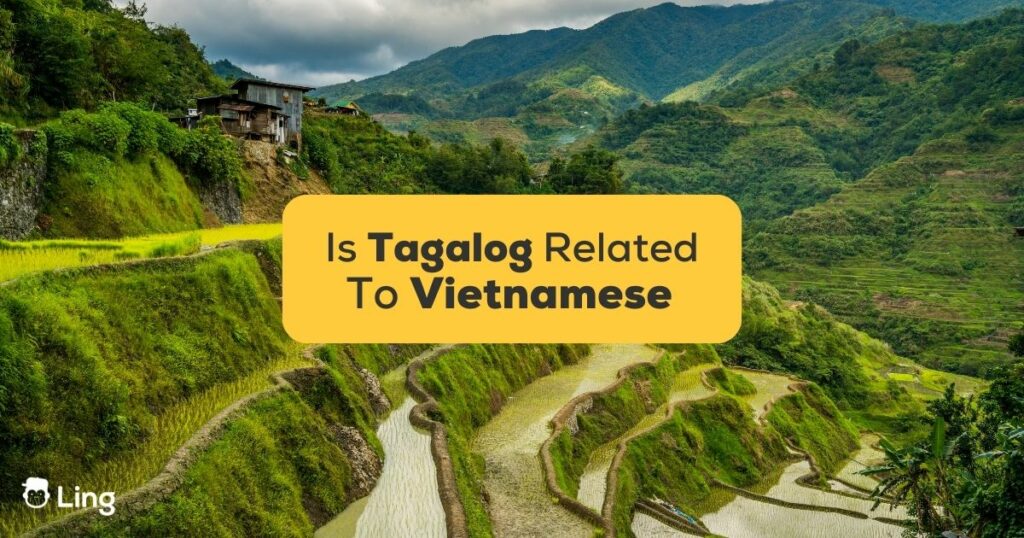“Is Tagalog Related To Vietnamese?” It’s a question that might have popped into your mind, especially if you’re someone who’s dipped their toes in the vast ocean of languages. We’ve all been there, haven’t we? Sitting in a bustling cafe, overhearing snippets of a conversation from the table next door, and wondering, “Hey, I recognize some of those sounds. Where have I heard them before?”
For some of us, it might have been during that backpacking trip in Southeast Asia, when the vibrant streets of Manila seemed to echo in the bustling markets of Ho Chi Minh City. For others, it might be that Filipino friend or Vietnamese neighbor whose family gatherings you’ve attended, where laughter and words flow freely. But how closely related are these two tongues that fill our memories and curiosities?
Let’s embark on this linguistic journey together and uncover the ties and tales between Tagalog and Vietnamese.
Tagalog Language
Tagalog isn’t just a language; it’s a narrative of the Philippines, elegantly wrapped up in syllables and expressions. Nestled in the heart of Luzon, this language is like a time capsule, preserving the history and emotions of millions. Ready for a fun fact? Tagalog’s linguistic roots stretch out to the expansive Malayo-Polynesian group. Imagine a linguistic family tree sprawling from Madagascar all the way to those dreamy Pacific islands.
Ever wonder why some Tagalog words sound eerily familiar to Spanish speakers? Well, with Spain’s 300-year pit stop in the Philippines, Tagalog got a Spanish flair. “Mesa,” “relo,” and “ventana” are just a few souvenirs from that era. Oh, and thanks to Uncle Sam’s brief stay, we now have “kompyuter” in our Tagalog lexicon.
Among the Philippines’ symphony of over 170 languages, Tagalog’s tune stands out. It’s so iconic that its alter ego, “Filipino”, proudly waves the national flag. Filipino movies, toe-tapping songs, and poignant literature are more than entertainment—they’re threads stitching together the nation’s vibrant tapestry.

Vietnamese Language
Ever heard Vietnamese spoken and felt its rhythm? That’s the heartbeat of Vietnam—articulated in tones, encapsulating its rich heritage. Vietnamese isn’t just a language; it’s an ancient tapestry depicting Southeast Asia’s soul.
Here’s a snippet from its origin story: stemming from the Austroasiatic clan, Vietnamese whispers tales of bygone civilizations from the Red River Delta. It’s like wine—aging, evolving, and refining with each passing era.
Here’s where it gets spicy: A millennium of being China’s neighbor meant more than just borrowing a cup of sugar. Classical Chinese was the VIP guest, shaping Vietnamese vocabulary. So, words like “bàn” and “trường”? Yup, that’s the Chinese touch. Oh, and if you’re sipping a “cà phê” in Hanoi, that’s a little French hat tip!
From the picturesque lanes of Hội An to the breathtaking terraces of Sapa, Vietnamese is more than words—it’s the nation’s welcoming embrace.

Is Tagalog Related To Vietnamese?
The intricate web of languages often leaves us pondering about their connections, origins, and evolutions. When examining Tagalog and Vietnamese, two prominent languages of Southeast Asia, the question arises: Are they related? The answer requires a deep dive into their linguistic roots, influences, and development trajectories.
Roots And Families
At the heart of every language lies its family – a group of languages linked by a common ancestor. Tagalog is a proud member of the Austronesian family, encompassing a vast array of languages spoken across the Pacific, from Taiwan to Madagascar. This family includes other Philippine languages, as well as distant tongues like Hawaiian and Malagasy.
Vietnamese, on the other hand, is rooted in the Austroasiatic family. This group, distinct from Austronesian, encompasses languages spoken primarily in mainland Southeast Asia, such as Khmer in Cambodia and Mon in Myanmar.
The Tonal And Phonetic Spectrum
Languages, like music, have their tones and rhythms. Vietnamese is tonal, meaning the pitch or modulation in the speaker’s voice can change a word’s meaning. With six distinct tones, it offers a melodic, complex linguistic experience. Tagalog, though non-tonal, has its own phonetic charm, with a rhythm influenced by its Austronesian lineage.
Influences And Intersections
Throughout history, both the Philippines and Vietnam encountered various foreign powers, leaving linguistic footprints. While Tagalog imbibed words from Spanish and English, Vietnamese embraced vocabulary from Chinese and French. These interactions, though significant, don’t indicate a direct relationship between Tagalog and Vietnamese, but rather show their adaptive capacities.
Shared Vocabulary
It’s not uncommon to find shared words or phonetic similarities between the two languages, given the trade, migration, and proximity of the two nations. However, these overlaps are more a result of contact than a shared linguistic origin.
So, Are They Related?
While both Tagalog and Vietnamese have etched their own unique stories in the annals of linguistics, their paths, by and large, have been distinct. They hail from different language families, evolved under varied influences, and possess unique phonetic attributes. Yet, in their own ways, both stand as testaments to the rich tapestry of Southeast Asian cultures and histories.
Learn Tagalog With Ling
Picture this: Tagalog and Vietnamese, two shimmering jewels of Southeast Asia, each carving their own narratives but both singing the vibrant chorus of the region’s layered past. Diving into their similarities and contrasts is like unlocking a treasure trove of human tales – of movement, mingling, and metamorphosis.
For the eager beavers keen to sway with the rhythm of Tagalog, we’ve got a treat for you! The golden key to mastering this lyrical language is just a tap away. Snag the Ling app from your App Store or Play Store and dive deep into a Tagalog tutorial that’s both enlightening and electric.
Fast forward, and imagine this: You, in the bustling heart of a Manila bazaar or lounging on a tranquil Filipino beach, crafting stories in pitch-perfect Tagalog. So, ready to turn that dream into a reality? Dive in and happy studying!



































































